外研版(2019)必修 第一册Unit 2 Exploring English Undersstanding ideas 课件(共20张PPT)
文档属性
| 名称 | 外研版(2019)必修 第一册Unit 2 Exploring English Undersstanding ideas 课件(共20张PPT) | 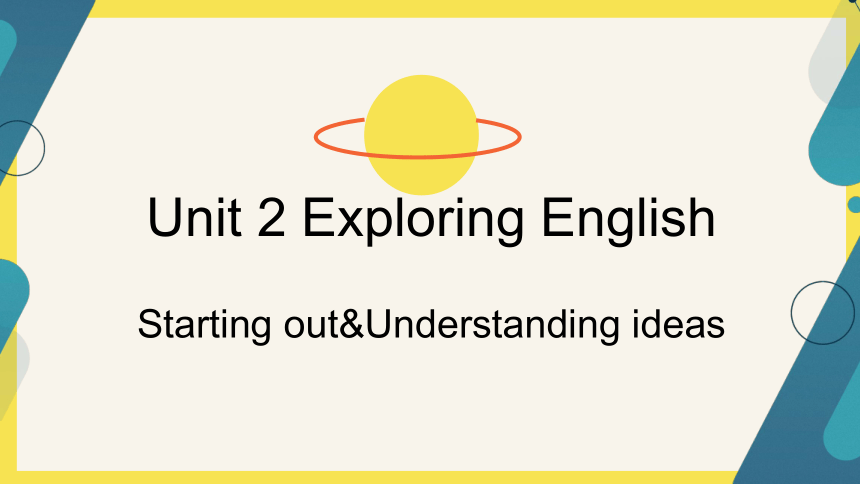 | |
| 格式 | pptx | ||
| 文件大小 | 13.4MB | ||
| 资源类型 | 教案 | ||
| 版本资源 | 外研版(2019) | ||
| 科目 | 英语 | ||
| 更新时间 | 2023-09-07 18:29:59 | ||
图片预览

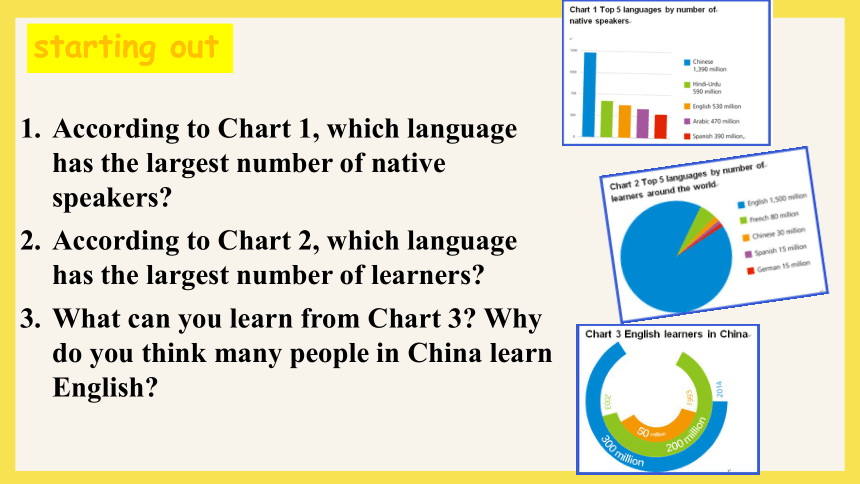
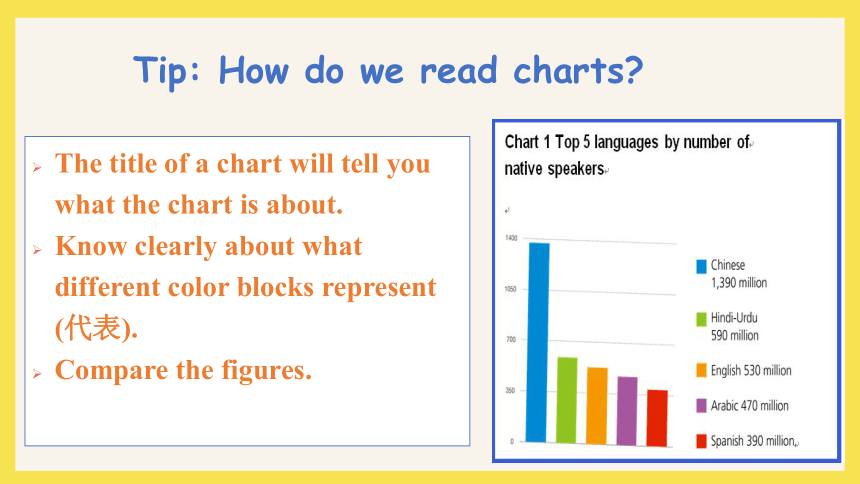


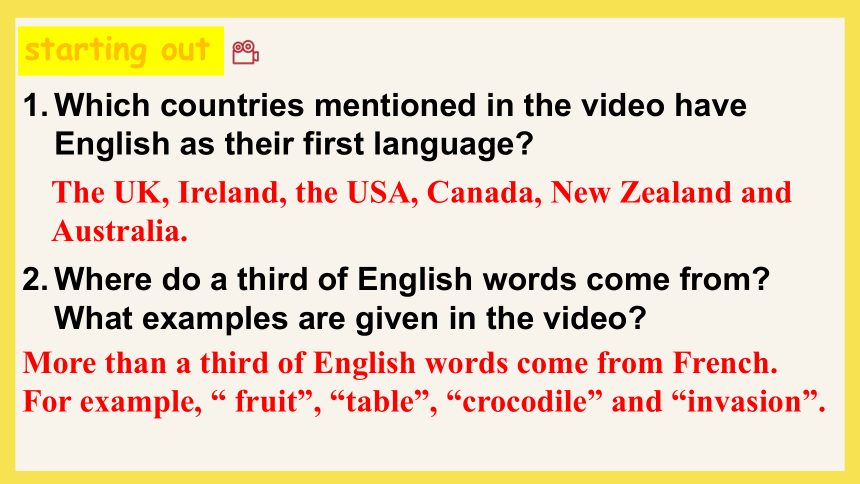
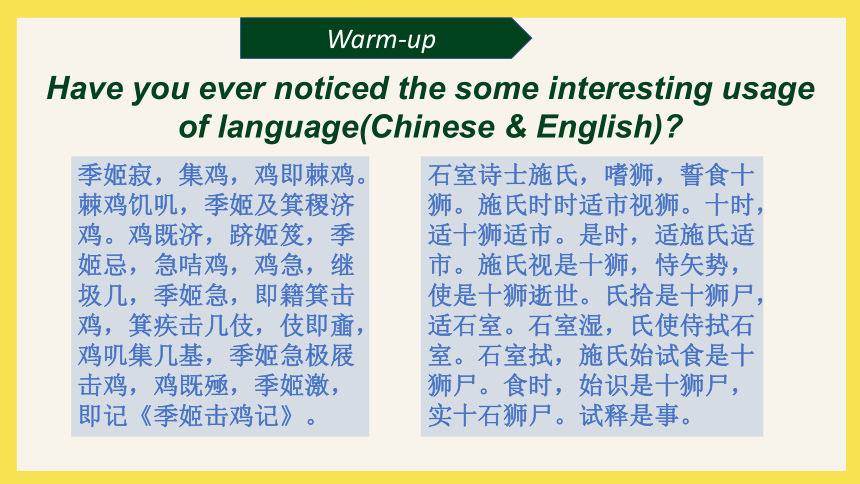
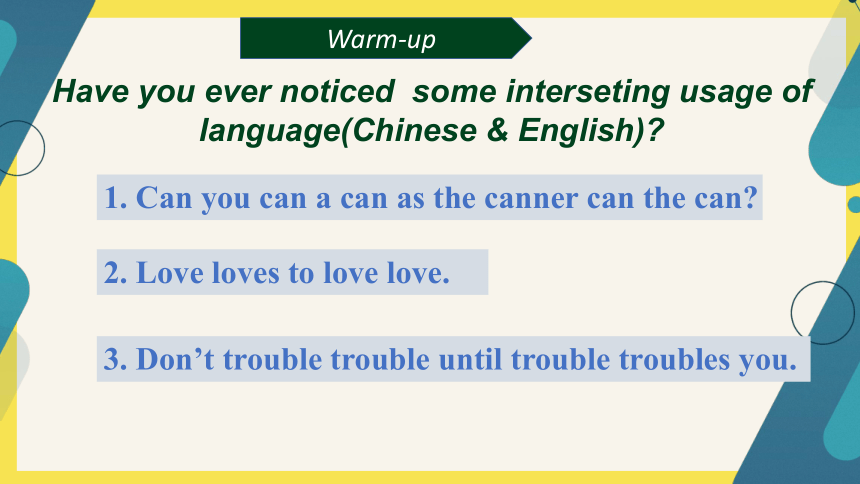

文档简介
(共20张PPT)
Unit 2 Exploring English
Starting out&Understanding ideas
starting out
According to Chart 1, which language has the largest number of native speakers
According to Chart 2, which language has the largest number of learners
What can you learn from Chart 3 Why do you think many people in China learn English
Tip: How do we read charts
The title of a chart will tell you what the chart is about.
Know clearly about what different color blocks represent (代表).
Compare the figures.
A bar chart can show the figures clearly and is easy for us to find out the comparison of numbers.
A pie chart can show the scale (比例) of
different part clearly.
A ring chart can show the figure scales to
each other.
Which countries mentioned in the video have English as their first language
Where do a third of English words come from What examples are given in the video
The UK, Ireland, the USA, Canada, New Zealand and Australia.
More than a third of English words come from French.
For example, “ fruit”, “table”, “crocodile” and “invasion”.
starting out
Warm-up
Have you ever noticed the some interesting usage of language(Chinese & English)
季姬寂,集鸡,鸡即棘鸡。棘鸡饥叽,季姬及箕稷济鸡。鸡既济,跻姬笈,季姬忌,急咭鸡,鸡急,继圾几,季姬急,即籍箕击鸡,箕疾击几伎,伎即齑,鸡叽集几基,季姬急极屐击鸡,鸡既殛,季姬激,即记《季姬击鸡记》。
石室诗士施氏,嗜狮,誓食十狮。施氏时时适市视狮。十时,适十狮适市。是时,适施氏适市。施氏视是十狮,恃矢势,使是十狮逝世。氏拾是十狮尸,适石室。石室湿,氏使侍拭石室。石室拭,施氏始试食是十狮尸。食时,始识是十狮尸,实十石狮尸。试释是事。
Warm-up
Have you ever noticed some interseting usage of language(Chinese & English)
1. Can you can a can as the canner can the can
2. Love loves to love love.
3. Don’t trouble trouble until trouble troubles you.
Neither Pine nor Apple in Pineapple
Understanding ideas
Activity 1
Look at the title of the passage and the pictures. Tick what you think the passage is about
pine + apple =pineapple
hamburger ham
eggplant egg
Activity 2
Read the passage quickly and silently and then match the main idea with each part.
Part1.(Para1) A. Examples of some
confusing expressions.
Part2.(Para2-6) B. The reason why English is
so crazy.
Part3.(Para7) C. English is a crazy language
to learn.
Tip for reading:
Pay attention to the first sentence of each paragraph.
How many kinds of examples are mentioned above
Activity 3
1. Choose the author's purpose in writing the passage.
1 To tell us that English is very difficult to learn.
2 To give advice on how to learn English.
3 To show that English is interesting and creative.
4 To explain how English was created.
2. How did the author develop the passage
A. By showing figures B. By giving examples
C. By answering questions D. By telling stories
Activity 4
In order to support his idea, the author uses many examples that show the 1.__________ madness of English.
no egg in eggplant no ham in 2.__________ neither pine nor apple in 3. ____________ sculpt a sculpture
paint a(n) 4.______________
BUT take a photo
unique
hamburger
pineapple
painting
We can’t always understand a compound word by adding the meanings of the words it is made up of!
Fill in the table!
reflects
In order to support his idea, the author uses many examples that show the unique madness of English.
seasick → sick at sea 5.___________ → sick in the air 6.___________ → sick in a car BUT 7. __________ → sick at home “Hard” is the opposite of “soft”.
“hardly “ and “softly” are not a(n) 8.___________ pair.
airsick
carsick
homesick
opposing
The same rule doesn’t always apply to everything!
Activity 4
reflects
In order to support his idea, the author uses many examples that show the unique madness of English.
“Harmless” is the opposite of “harmful”. Shameful and shameless 9.__________ are the same. burn up → burn down
fill in a form → 10. _______a form
behaviors
fill out
Different words or phrases may have the same meaning!
Activity 4
reflects
Different words or phrases may have the same meaning!
In order to support his idea, the author uses many examples that show the unique madness of English.
Stars are out . → They are visible. Lights are out. → They are 11.__________. I wind up my watch. →It starts.
I wind up the passage. →
It 12.________.
The reason is that English was invented by people, and it 13.___________the creativity of the human race.
invisible
ends
reflects
The same words and phrases may have different meanings in different contexts.
Activity 4
Activity 5
Read the following information and answer the questions.
The word “pineapple” developed from the Spanish word “pina”, which means pine cone when it came to England, “ apple” was added to show it is a kind of fruit.
The origin of “hamburger” was a hard beef steak called “ Hamburg steak” , eaten without bread. Later, people reinvented it and called it “hamburger”.
Eggplants used to be smaller and yellow or white. They looked a bit like eggs, which led to the name “eggplant”.
How did pineapples, hamburgers and eggplants get their names
Think and share
Can you think of similar examples in Chinese For example, there isn’t a wife in a “Laopobing”
Thank you!
Unit 2 Exploring English
Starting out&Understanding ideas
starting out
According to Chart 1, which language has the largest number of native speakers
According to Chart 2, which language has the largest number of learners
What can you learn from Chart 3 Why do you think many people in China learn English
Tip: How do we read charts
The title of a chart will tell you what the chart is about.
Know clearly about what different color blocks represent (代表).
Compare the figures.
A bar chart can show the figures clearly and is easy for us to find out the comparison of numbers.
A pie chart can show the scale (比例) of
different part clearly.
A ring chart can show the figure scales to
each other.
Which countries mentioned in the video have English as their first language
Where do a third of English words come from What examples are given in the video
The UK, Ireland, the USA, Canada, New Zealand and Australia.
More than a third of English words come from French.
For example, “ fruit”, “table”, “crocodile” and “invasion”.
starting out
Warm-up
Have you ever noticed the some interesting usage of language(Chinese & English)
季姬寂,集鸡,鸡即棘鸡。棘鸡饥叽,季姬及箕稷济鸡。鸡既济,跻姬笈,季姬忌,急咭鸡,鸡急,继圾几,季姬急,即籍箕击鸡,箕疾击几伎,伎即齑,鸡叽集几基,季姬急极屐击鸡,鸡既殛,季姬激,即记《季姬击鸡记》。
石室诗士施氏,嗜狮,誓食十狮。施氏时时适市视狮。十时,适十狮适市。是时,适施氏适市。施氏视是十狮,恃矢势,使是十狮逝世。氏拾是十狮尸,适石室。石室湿,氏使侍拭石室。石室拭,施氏始试食是十狮尸。食时,始识是十狮尸,实十石狮尸。试释是事。
Warm-up
Have you ever noticed some interseting usage of language(Chinese & English)
1. Can you can a can as the canner can the can
2. Love loves to love love.
3. Don’t trouble trouble until trouble troubles you.
Neither Pine nor Apple in Pineapple
Understanding ideas
Activity 1
Look at the title of the passage and the pictures. Tick what you think the passage is about
pine + apple =pineapple
hamburger ham
eggplant egg
Activity 2
Read the passage quickly and silently and then match the main idea with each part.
Part1.(Para1) A. Examples of some
confusing expressions.
Part2.(Para2-6) B. The reason why English is
so crazy.
Part3.(Para7) C. English is a crazy language
to learn.
Tip for reading:
Pay attention to the first sentence of each paragraph.
How many kinds of examples are mentioned above
Activity 3
1. Choose the author's purpose in writing the passage.
1 To tell us that English is very difficult to learn.
2 To give advice on how to learn English.
3 To show that English is interesting and creative.
4 To explain how English was created.
2. How did the author develop the passage
A. By showing figures B. By giving examples
C. By answering questions D. By telling stories
Activity 4
In order to support his idea, the author uses many examples that show the 1.__________ madness of English.
no egg in eggplant no ham in 2.__________ neither pine nor apple in 3. ____________ sculpt a sculpture
paint a(n) 4.______________
BUT take a photo
unique
hamburger
pineapple
painting
We can’t always understand a compound word by adding the meanings of the words it is made up of!
Fill in the table!
reflects
In order to support his idea, the author uses many examples that show the unique madness of English.
seasick → sick at sea 5.___________ → sick in the air 6.___________ → sick in a car BUT 7. __________ → sick at home “Hard” is the opposite of “soft”.
“hardly “ and “softly” are not a(n) 8.___________ pair.
airsick
carsick
homesick
opposing
The same rule doesn’t always apply to everything!
Activity 4
reflects
In order to support his idea, the author uses many examples that show the unique madness of English.
“Harmless” is the opposite of “harmful”. Shameful and shameless 9.__________ are the same. burn up → burn down
fill in a form → 10. _______a form
behaviors
fill out
Different words or phrases may have the same meaning!
Activity 4
reflects
Different words or phrases may have the same meaning!
In order to support his idea, the author uses many examples that show the unique madness of English.
Stars are out . → They are visible. Lights are out. → They are 11.__________. I wind up my watch. →It starts.
I wind up the passage. →
It 12.________.
The reason is that English was invented by people, and it 13.___________the creativity of the human race.
invisible
ends
reflects
The same words and phrases may have different meanings in different contexts.
Activity 4
Activity 5
Read the following information and answer the questions.
The word “pineapple” developed from the Spanish word “pina”, which means pine cone when it came to England, “ apple” was added to show it is a kind of fruit.
The origin of “hamburger” was a hard beef steak called “ Hamburg steak” , eaten without bread. Later, people reinvented it and called it “hamburger”.
Eggplants used to be smaller and yellow or white. They looked a bit like eggs, which led to the name “eggplant”.
How did pineapples, hamburgers and eggplants get their names
Think and share
Can you think of similar examples in Chinese For example, there isn’t a wife in a “Laopobing”
Thank you!
